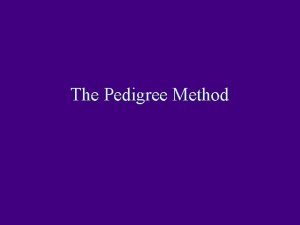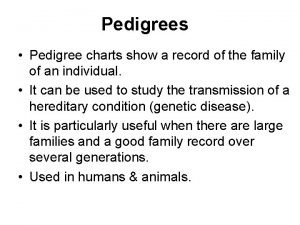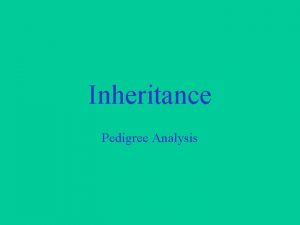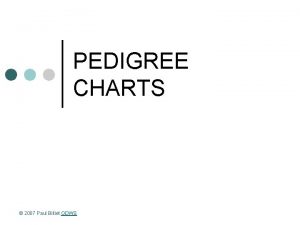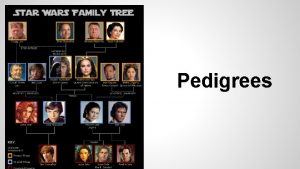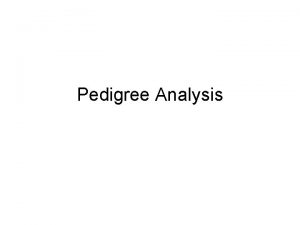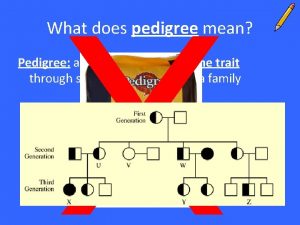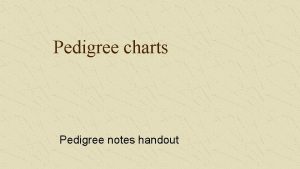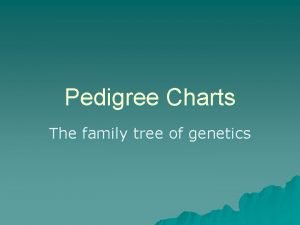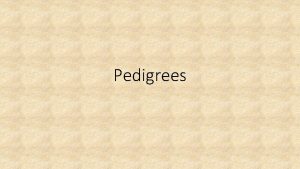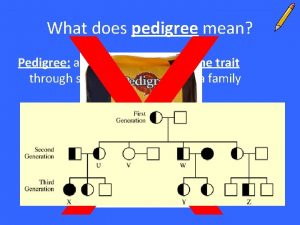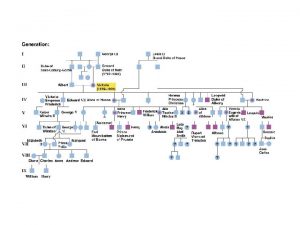The Pedigree Method History Practice of the pedigree






















- Slides: 22

The Pedigree Method

History • Practice of the pedigree method predates rediscovery of Mendel’s work • Vilmorin used the pedigree method in France in the 1830’s • Institute at Svalof - used pedigree type breeding in the 1880’s

Nillson • Represented families by one or more plants • Noted that when harvested seed came from only one plant, the progeny were much more uniform • Came to call this the “system of pedigree”

Begin with the F 2 generation • May be space planted to provide maximum individual plant expression • May be planted at the same density as the crop normally is

F 2 plant selection • Identify best plants, e. g. short, early, clean, vigorous • Tag or spray paint plants to signify selects • May tag at flowering to indicate traits that will not be readable at maturity • Historical - pull or dig up whole plants at maturity to provide plenty of F 2: 3 seed

F 2 Selection • To harvest (dig up) single plants or simply harvest single heads is a decision with several implications • Single head harvest is much quicker and easier, but it limits the amount of seed and thus the experimental unit that is grown in the F 3

F 2 selection • Space-planted or solid seeded - another critical decision • Space planted populations allow for individual plant expression, maximum tillering (etc. ), and maximum individual plant yield • But if it does not mirror the way the crop is grown, how “real” is it?

Variability Issues Generation Among Within F 2: 3 1 0. 5 F 3: 4 F 4: 5 1. 75 0. 25 0. 125 F 5: 6 1. 875 0. 0625

Selection Pressure / No. of Lines • Maximize the number of F 2: 3 lines because the among line variation is greater than the within line variation • If you do not maximize the number of distinct F 2: 3 families, then you will be relying on within line variation, which is of diminishing magnitude as inbreeding progresses.


Selection Pressure / No. of Lines • If you have selected only 5 - 10 plants from an F 2 population, then you will be relying on variation within inbred lines that trace back to those few F 2 plants. • The problem is that theory tells us that the within line variation will simply not be there.

Pedigree Information • The keeping of pedigree information is very tedious • One rationale for keeping it is to make sure that lines trace back to different F 2 plants

Pedigree Information • Sister lines - what are they? • Pedigree information allows us to keep track of sister lines • E. g. 1) KY 95 C - 100 - 14 -23 - 8 - 6 - 0 and 2) KY 95 C - 100 - 14 -25 -2 - 0 and 3)KY 95 C - 100 - 14 -23 - 8 - 12 - 0 • 1 and 2 are sisters at the F 2: 3 level and 1 and 3 are sisters at the F 4: 5 level

Characters for Selection • High heritability desirable • Amenable to visual selection • Traits that can be evaluated in individual plants or progeny rows • Number of plants grown must be adequate for number of traits evaluated • Must maintain sufficient number of plants such that variability for low h 2 traits like yield still remains.

Choice of Environments • Assume F 2 will be grown in main nursery environment (ex. Lexington) • With pedigree selection, early generations will all be grown there because individual plant selection is practiced • Alternative is to grow a bulk version of a generation at another location

Pros • Discard inferior types early • Each generation grown in different year which exposes material to different environments • Genetic relatedness of lines known, so variability among lines retained can be maximized

Cons • Can’t be used in environments where genetic variability for trait not expressed (off season nursery) • Tremendous record keeping • May need experienced person to select • Land labor intensive

Pedigree Selection • Most breeders use some aspect of it • Few breeders use very strict pedigree selection • Too expensive and labor intensive • May be most suitable for small program where quality considerations limit size and genetic variability (e. g. , malting barley)

Pedigree of Compton Wheat Fulhio / Purkof /3/ Trumbull // Hope / Hussar /5/ Fairfield /4/ PI 94587 /3/ Hungarian // Fultz / Hungarian /8/ La. Porte /7/ Minhardi / Wabash /5/ Fultz / Hungarian // Illinois No. 1, W 38 /3/ Wabash /4/ Fairfield /6/ Redcoat / Wisconsin 245 / Afghanistan /9/4* Knox /8/( Purdue 5127 ) Kawvale /5/ Fultz / Hungarian // Illinois No. 1, W 38 /3/ Wabash /4/ Fairfield /6/3* Trumbull // Hope / Hussar /7/ Knox sib /5/ Fairfield /4/ PI 94587 // Fultz / Hungarian /3/ Fultz / Hungarian / 10 /2* Knox / Frex // Riley sib.



 The pedigree below tracks duchenne muscular dystrophy
The pedigree below tracks duchenne muscular dystrophy Symposium method of teaching
Symposium method of teaching Pedigree method flow chart
Pedigree method flow chart Why are karyotypes useful diagrams
Why are karyotypes useful diagrams Myeplg website
Myeplg website Ap world history saq
Ap world history saq World history semester 2 exam review
World history semester 2 exam review Xxcx.con
Xxcx.con American history regents review
American history regents review Also history physical
Also history physical Hình ảnh bộ gõ cơ thể búng tay
Hình ảnh bộ gõ cơ thể búng tay Frameset trong html5
Frameset trong html5 Bổ thể
Bổ thể Tỉ lệ cơ thể trẻ em
Tỉ lệ cơ thể trẻ em Chó sói
Chó sói Thang điểm glasgow
Thang điểm glasgow Alleluia hat len nguoi oi
Alleluia hat len nguoi oi Các môn thể thao bắt đầu bằng tiếng bóng
Các môn thể thao bắt đầu bằng tiếng bóng Thế nào là hệ số cao nhất
Thế nào là hệ số cao nhất Các châu lục và đại dương trên thế giới
Các châu lục và đại dương trên thế giới Công thức tính thế năng
Công thức tính thế năng Trời xanh đây là của chúng ta thể thơ
Trời xanh đây là của chúng ta thể thơ Mật thư anh em như thể tay chân
Mật thư anh em như thể tay chân


